Dependence Viscosity of Temperature and Shear Rate for Vegetable Oil Used as Biodegradable Lubricant
University of Bucharest, Faculty of Chemistry, Department of Physical Chemistry, 4-12 Elisabeta Blvd, 030018, Bucharest, Romania
Corresponding Author E-mail: Istanciu75@yahoo.com
DOI : http://dx.doi.org/10.13005/ojc/360329
Article Received on : 18 Apr 2020
Article Accepted on : 04 Jun 2020
Article Published : 06 Jun 2020
This article presents the dependence on the dynamic viscosity of the temprature and the shear rate for the vegetable oils (soybean, corn, olives, rapeseed) used as biodegradable lubricants. From the reogrames we observe a decrease of the dynamic viscosity with temprature and the shear rate for all four types of oils. Of the vegetable oils analyzed, the dynamic viscosity of rapeseed oil is most strongly influenced by the shear rate, followed by that of olive oil, corn oil and soybean oil.
KEYWORDS:Oil Vegetable; Temperature; Viscosity
Download this article as:| Copy the following to cite this article: Stanciu I. Dependence Viscosity of Temperature and Shear Rate for Vegetable Oil Used as Biodegradable Lubricant. Orient J Chem 2020;36(3). |
| Copy the following to cite this URL: Stanciu I. Dependence Viscosity of Temperature and Shear Rate for Vegetable Oil Used as Biodegradable Lubricant. Orient J Chem 2020;36(3). Available from: https://bit.ly/3eTJJYi |
Introduction
Lubricant is any substance interposed between two surfaces in order to reduce friction and / or wear between them. The lubricant is a body interposed between the surfaces of the rubbing joint. It may be naturally present or may be intentionally brought in to reduce friction and wear or to remove heat generated by friction, [1-6]. From the point of view of origin, there are mineral, synthetic and lubricants of plant or animal origin [7,8].
Until the nineteenth century, the basic components used in the manufacture of lubricants were vegetable oils and animal fats. They were compatible with the environment and biodegradable. Thus, as early as 2500 BC, the Egyptians found that vegetable oil reduced friction if applied under the soles of sleds carrying heavy stones for the construction of pyramids. Also in the Greco-Roman period, vegetable oils were used to reduce friction. In the southern countries, poppy or olive oils were used, while in the northern regions rapeseed oil was used [9,10].
Vegetable oils are obtained from the seeds of oilseeds, textile-oilseed plants and from various oilseeds. The most widespread oil plants are: sunflower (Helianthus annuus) (Russia, Argentina, Romania), soybean (Glycine hispida) (China, USA, Russia), rapeseed (Brassica napus) (India, China, Canada, Poland), castor bean (Ricinus communis) (USA, Italy, Turkey, France, Romania) and peanuts (Arachis hypogaea) (India, China, Mexico, Spain, Italy). Other sources of vegetable oils include cotton, corn, olives, saffron, flax, palm, coconut, tungsten etc. [11,12].
Vegetable oils are composed of 98-99% of fatty acids whose characteristics differ by the number of carbon atoms, the number of double bonds between carbon atoms and the position of these bonds in the fatty acid molecule [13,14].
The Fatty Acid Groups are
Saturated acids (without double bonds) – myristic acid, palmitic acid, stearic acid, etc .;
Monounsaturated acids (only with a double bond) – oleic acid, erucic acid;
Polyunsaturated acids (with multiple double bonds) – linoleic acid, linolenic acid;
Special acids (containing hydroxy, epoxy, etc.).
The most important fatty acids contained in vegetable oils are: oleic acid (C18: 1), linoleic acid (C18: 2) and linolenic acid (C18: 3), as well as palmitic acid (C16: 0) and stearic acid (C18: 0) [15,16].
The most important sources for natural esters are rapeseed oil, sunflower and soy.
For vegetable oils, important properties are: density relative to 20ºC, saponification index, iodine index (which indicates the degree of dryness of vegetable oil, determined by the proportion of polyunsaturated fatty acids), the peroxide index, the mass fraction of water and volatile substances, refractive index [17-20].
Material and Methods
The rheological behaviour of oils ( soybean, corn, oilve and rapeseed) was determined using a Haake VT 550 Viscotester developing shear rates ranging between 3 and 120 s-1 and measuring viscosities from 104 to 106 mPa.s when the HV1 viscosity sensor is used. The temperature ranged between 313 and 373K. The accuracy of the temperature was 0.1oC.
Results and Discussion
The viscosity decreases with increasing shear rate (Fig. 1 and 2). The decrease in viscosity is much more pronounced at low shear rates. As the shear speed increases, relatively small decreases in dynamic viscosity are observed.
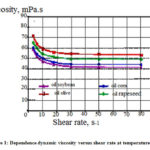 |
Figure 1: Dependence dynamic viscosity versus shear rate at temperature 300C |
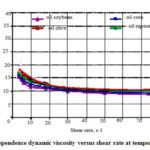 |
Figure 2: Dependence dynamic viscosity versus shear rate at temperature 900C |
Analyzing the graphs in Figures 1 and 2 it can be observed: in the case of soybean oil tested at 30 ° C, a decrease of dynamic viscosity by 29.88% over the entire range of shear rates, for the same test conditions, the viscosity of the oil maize decreased by 26.83%; in the case of rapeseed oil a decrease with 24.27% of the dynamic viscosity was observed and for the olive oils the dynamic viscosity decreased by 25.1%. Of the vegetable oils analyzed, the dynamic viscosity of rapeseed oil is most strongly influenced by the shear rate, followed by that of olive oil, corn oil and soybean oil. For the test temperature of 90 ° C a decrease of the dynamic viscosity by 44.26% is observed in the case of soybean oil, the viscosity of the corn oil decreased by 42.87%; In the case of olive oil, a decrease of 43.88% was observed.
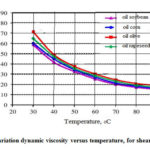 |
Figure 3: Variation dynamic viscosity versus temperature, for shear rate 3.3s-1 |
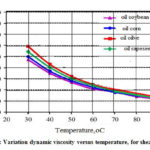 |
Figure 4: Variation dynamic viscosity versus temperature, for shear rate 10s-1 |
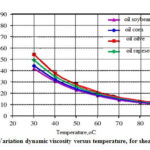 |
Figure 5: Variation dynamic viscosity versus temperature, for shear rate 30s-1 |
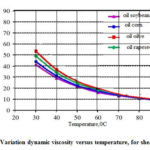 |
Figure 6: Variation dynamic viscosity versus temperature, for shear rate 80s-1 |
Figures 3, 4, 5 and 6 show the variation of dynamic viscosity with temperature at different shear rates. From the graphs it is observed that the dynamic viscosity decreases with increasing temperature. The values of the dynamic viscosity of the oils tend to become very close as the temperature and the shear rate increase. This behavior was also observed in the works [17,18].
At the shear rate of 3.3 s-1 the smallest percentage variation of the dynamic viscosity has the olive oil (73.47%), followed by the corn oil (73.54%), then the rapeseed oil (73.89%) and soybean oil (74.1%).
For the shear rate of 30 s-1, the smallest percentage variation of the dynamic viscosity has the soybean oil (76.03%), followed by the corn oil (76.36%), followed by the rapeseed oil (77.72%) and olive oil (78.27%).
For the shear rate of 80 s-1, the smallest percentage variation of the dynamic viscosity has corn oil (79.34%), followed by soybean oil (79.36%), followed by rapeseed oil (79, 81%) and olive oil (80.12%).
There are slight differences between the percentage decreases of the dynamic viscosity for the vegetable oils, probably because these oils have similar chemical compositions.
Conclusions
The dynamic viscosity of the studied oils decreases with temperature and shear rate due to the fact that these oils have similar chemical composition. Of the vegetable oils analyzed, the dynamic viscosity of rapeseed oil is most strongly influenced by the shear rate, followed by that of olive oil, corn oil and soybean oil.
References
- Crudu I., On the concept of tribosystem and tribomodelling criterion, Proc. of 4 th. European Tribology Congress, Eurotrib 85, Lyon, Vol IV, 1985.
- Crudu I., Tribosistem-Tribomodel în studiul sistemelor mecanice, Editura Galaţi University Press, Galaţi, 2008.
- O’ Connor J.J., Boyd J., Avallone E.A., Standard Handbook of Lubrication Engineering, Mc Graw-Hill Book Company, 1968
- Stachowiak G.W., Batchelor A.W., Engineering Tribology, Elsevier, Amsterdam, 1993.
- Ştefănescu I., Deleanu L., Ripa M., Lubrifiere şi lubrifianţi, Editura Europlus, Galaţi, ISBN 978-973-7845- 93-1, 2008.
- Stepina V., Vesely V., Lubricants and Special Fluids, Elsevier Science B.V, Amsterdam, ISBN 0-444-98674-X, 1992.
- Olaru D., Fundamente de lubrificaţie, Editura Gh. Asachi, Iaşi, 2002.
- Pascovici M. D., Cicone T., Elemente de tribologie, Ed. BREN, Bucureşti, 2001.
- Hohn B. R., Michaelis K., Dobereiner R., 1999, Lubr. Eng..
- Ştefănescu I., Calomir C., Spanu C., The Annals of ,,Dunărea de Jos” University of Galaţi, fascicle VIII, Tribology 2003, 237-242.
- Lambert W. J., Johnson I. J., Vegetable oil Lubricants for internal combustion engines and total loss lubrication, US Patent Nr. 5888947, 1999.
- Ştefănescu I., Cercetări privind îmbunătăţirea proprietăţilor tribologice şi creşterea stabilităţii la oxidare a lubrifianţilor ecologicipe bază de uleiuri vegetale, Sinteză Grand, faza III, tema 7,cod CNCSIS 1049, 2005.
- Gülsüm P., Bio-based Lubricants, Opet Petrolcülük A.Ş., AOSB-Izmir, 2008.
- Stachowiak G.W., Batchelor A.W., Engineering Tribology, Butterworth-Heinemann, Team Lrn, 2005.
- Stanciu I., Oriental Journal of Chemistry, 2015, 31(3), 1383-1387.
- Stanciu I., Oriental Journal of Chemistry, 2015, 31(4), 2017-2023.
- Wan Nik W., Ani F. N., Masjuki H. H., Eng Giap S. G., 2005, 22, 249-255.
- Goodrum J. W., Law S. E., Am. Soc. Agic. Eng., 1982, 897- 900.
- 19.Stanciu I.; Journal of Science and Arts 2017, 4(41), 771-778.
- Stanciu I.; Journal of Science and Arts 2018, 1(42), 197-202

This work is licensed under a Creative Commons Attribution 4.0 International License.










